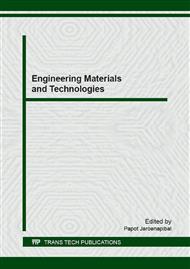p.139
p.143
p.148
p.157
p.163
p.169
p.177
p.184
p.191
Use of Recycled Concrete Aggregate in High-Calcium Fly Ash Geopolymer Concrete
Abstract:
The comparison results of using crushed limestone (NA) and recycled concrete aggregates (RCA) as coarse aggregates in high-calcium fly ash geopolymer concrete with and without temperature curing are presented. Local river sand with a fineness modulus of 2.1, sodium hydroxide solution concentrations of 8, 12, and 16 Molar, and sodium silicate were used to produce geopolymer concrete (GC). The curing was separated in two conditions: the first was cured at ambient temperature (AT) and another was cured at temperature of 60°C for 48 hrs. (CT). The compressive strength, thermal conductivity, and ultra pulse velocity of GC were investigated at age 7 days. The results found that RCA could be use as coarse aggregate in GC. The thermal conductivity increased with the increasing of compressive strength. Curing at 60°C yielded compressive strength about 3 times higher than that of AT. However, both AT and CT curing, GC containing RCA had thermal conductivity and ultra pulse velocity lower than those of containing NA.
Info:
Periodical:
Pages:
163-168
Citation:
Online since:
November 2016
Authors:
Price:
Сopyright:
© 2017 Trans Tech Publications Ltd. All Rights Reserved
Share:
Citation:


